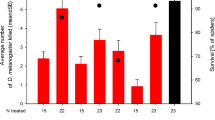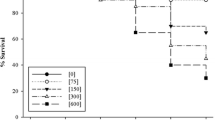Abstract
Experiments were carried out with deltamethrin using the epigeal erigonid spiderOedothorax apicatus. The spiders were exposed to spray, residues and contaminated food. Exposure in the field, of spiders and their major prey items (collembolans) to the spray, was measured by means of a fluorescent tracer. The quantities of spray fluid recovered from these organisms was lower than the quantity measured on surfaces exposed to the spray on the soil. The availability of residues on soil was assessed by exposing individuals to sprayed soils of varying moisture content, to a soil showered after spraying and by exposing topically treated spiders to unsprayed soils. The effects of the residues were strongly related to the water content of the soil. On sprayed soils at field capacity, the toxic effects were highest. A shower shortly after spraying reduced the effect of residues considerably. On very dry soils (12.5% of field capacity) high effects were also observed both on sprayed and unsprayed soils. This effect could be attributed to unfavorable air humidity conditions near the soil surface. The relative contribution of the three routes of uptake, i.e. exposure to spray and to residues and consumption of contaminated prey, was studied with radio-labelled deltamethrin. Spiders were exposed to sprayed soil surfaces (moisture content 75% of field capacity), topically treated and fed with topically treated fruit flies. The latter route contributed little to the body burden. The amount of deltamethrin absorbed from the soil was twice the amount absorbed after topical treatment.
Similar content being viewed by others

References
Atkins EL, Kellum D, Atkins KW (1978) Integrated pest management strategies for protecting honeybees from pesticides. Amer Bee J, August 1978, 542 (1978)
Aukema B, Van den Berg JHJ, Leopold A, Jagers op Akkerhuis GAJM & Everts JW (in press) A method for testing the toxicity of residues of pesticides on standardized substrate to erigonid an linyphiid spiders. J Appl Entomol
Everts JW, van Frankenhuyzen K, Román B, Koeman JH (1983) Side effects of experimental pyrethroid applications for the control of tsetse flies in a riverine forest habitat (Africa). Arch Environ Contam Toxicol 12:91
Everts JW, Kortenhoff BA, Hoogland H, Vlug HJ, Jocqué R, Koeman JH (1985) Effects on non-target terrestrial arthropods of synthetic pyrethroids used for the control of tsetse fly (Glossina spp) in settlement areas of the Southern Ivory Coast, Africa. Arch Environ Contam Toxicol 14:641
Everts JW, Aukema B, Hengeveld R, Koeman JH (1989) Side-effects of pesticides on ground-dwelling predatory arthropods in arable ecosystems. Environ Pollut 59:203
Everts JW, Willems I, Stulp M, Simons L, Aukema B, Kammenga J (1991) The toxic effect of deltamethrin on linyphiid and erigonid spiders in connection with ambient temperature, humidity and prédation. Arch Environ Contam Toxicol 20:20–24
Gestel CAM van, Ma WC (1988) Toxicity and bioaccumulation of chlorophenols in earthworms in relation to bioavailability in soil. Ecotoxicol Environ Safety 15:289
Harris CR, Turnbull SA (1978) Laboratory studies on the contact toxicity and activity in soil of four pyrethroid insecticides. Can Entomol 110:258
Hill BA, Schaalje CB (1985) A two-compartment model for the dissipation of deltamethrin on soil. J Agric Food Chem 33:1001
Potter C (1952) An improved laboratory apparatus for applying direct sprays and surface films, with data on the electrostatic charge of atomized spray fluids. Ann Appl Biol 39(1): 1
Richards LA (1965) Physical condition of water in soil. Chapter 8. In: Black CA (ed) Methods of soil analysis. Part I. Physical and mineralogical properties, including statistics of measurement and sampling. No. 9, Series Agronomy. Fifth edition. American Soc of Agronomy Inc. Publisher, Madison, Wisconsin, USA
Ten Houten JG, Kraak M (1949) A vertical spraying apparatus for the laboratory evaporation of all types of liquid pest control materials. Ann Appl Biol 36(3):394
Author information
Authors and Affiliations
Rights and permissions
About this article
Cite this article
Everts, J.W., Aukema, B., Mullié, W.C. et al. Exposure of the ground dwelling spiderOedothorax apicatus (Blackwall) (Erigonidae) to spray and residues of deltamethrin. Arch. Environ. Contam. Toxicol. 20, 13–19 (1991). https://doi.org/10.1007/BF01065322
Received:
Revised:
Issue Date:
DOI: https://doi.org/10.1007/BF01065322



